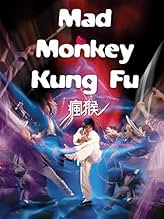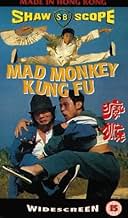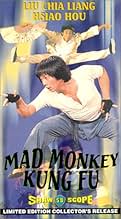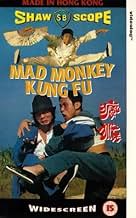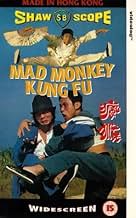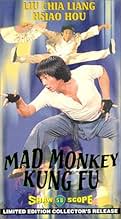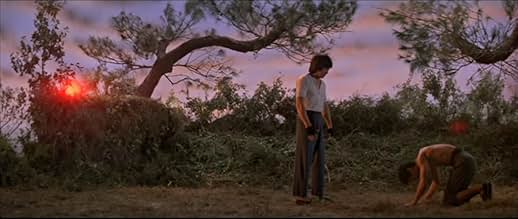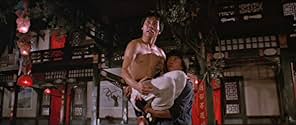IMDb RATING
6.7/10
1.2K
YOUR RATING
A disgraced former Kung Fu expert makes a living as a merchant with the help of a hot headed friend. When the men are harassed by gangsters, the merchant decided to teach his friend monkey b... Read allA disgraced former Kung Fu expert makes a living as a merchant with the help of a hot headed friend. When the men are harassed by gangsters, the merchant decided to teach his friend monkey boxing so they can defend their business.A disgraced former Kung Fu expert makes a living as a merchant with the help of a hot headed friend. When the men are harassed by gangsters, the merchant decided to teach his friend monkey boxing so they can defend their business.
- Awards
- 1 nomination total
Kara Ying Hung Wai
- Miss Chen
- (as Ying-Hung Hui)
Wing-Hon Cheung
- Green Dragon
- (as Yung-Han Chang)
Fung Ging-Man
- Stage Manager
- (as Ging-Man Fung)
- Director
- Writer
- All cast & crew
- Production, box office & more at IMDbPro
Storyline
Did you know
- Alternate versionsThe 1995 UK video version is cut by 28 seconds.
- ConnectionsFeatured in 42nd Street Forever, Volume 5: The Alamo Drafthouse Edition (2009)
Featured review
Liu Chia-Liang or Lau Kar-Leung learned martial arts from his father who was a student of Lam Sai-Wing who was the number one student of Wong Fei-Hung. He learned fight choreography on the set of the early Wong Fei Hung movies starring Kwan Tak-Hing. I consider him to be the greatest man in the history of martial arts movies and dub him the Grandmaster.
A perfect martial arts movie is composed of these elements – real martial arts, Chinese opera, puppetry and storytelling. More specifically, those are the elements essential to a perfect fight sequence.
First element is real martial arts. This is obvious because the fight has to appear to be real. The individual moves have to actually work. However, the fight cannot be too real. Real fights are all the same and pretty much boring to watch. First the fighters throw a few moves from distance to close, then they fight in a clench, then they go to the ground. The audience gets bored starting at the clench.
Chinese opera keeps the fight from becoming boring. It adds an element of acrobatics that serves to keep the fight at a distance and thereby avoids the clench. Even if fighting close the action can keep going and even on the ground the elements of Chinese opera keep the fight interesting to watch instead of looking at two guys rolling around on the ground until they get tired.
China is also famous for puppetry. This element added the wire work to the fights. The actors could do gravity defying acrobatics and even the props could be controlled to follow specific paths of action.
The last element is storytelling and there is nothing specifically Chinese about it. In a good fight the viewer should be able to tell why these people are fighting and the story should be advanced by the fight. John Kreng calls this the art of non-verbal dialogue. This element is the most difficult and is often missed altogether but the greats like Liu Chia-Liang made some of the best movie ever by adding this element.
I consider these the Grandmaster's greatest movies, in chronological order: "Challenge of the Masters", "Executioners from Shaolin", "Heroes of the East", "The 36th Chamber of Shaolin", "Dirty Ho", "My Young Auntie", and "Legendary Weapons of China". I consider "Legendary Weapons of China" the greatest martial arts movie ever made and have reviewed it and rated it a perfect 10.
I am often asked "What was the best fight scene ever?" This question is really impossible to answer. It is totally subjective and how does one even define the qualities that make the best fight scene ever? Recently I began a project of watching every martial arts movie ever made in chronological order. I came to one conclusion from that effort. I believe absolutely that on May 7, 1976 (the release date of "Challenge of the Masters") the best fight scene ever filmed as of that day was the fight scene in that movie with Lia Chiu-Liang against his brother Lau Kar-Wing. The runner–up would be his fight against Gordon Liu in the same movie. Since then there are thousands of possible best fight scenes.
Where does "Mad Monkey Kung Fu" take its place in all this greatness? Off the list. It opens with Uncle Chan's downfall due to his character flaw of drinking. The circumstances are contrived and unbelievable yet presented as good entertainment so despite the stretch of believability it all works. The action for the first 48 minutes is minimal and the sequences short. Hsiao Ho gets on the ropes in the training sequence and kicks it up a notch. Greatness begins at about 1:02 minutes with the comedy fight against the protection gang and continues to the brothel. Another contrived and cliché scene this time involving eavesdropping) ties up the plot.
The final fight is back at the brothel and runs about ten minutes. It is really good yet many fight scenes in many movies were really good.
I like this movie and recommend it for anyone. Critically, though, it does not make the list of the Grandmaster's best movies.
A perfect martial arts movie is composed of these elements – real martial arts, Chinese opera, puppetry and storytelling. More specifically, those are the elements essential to a perfect fight sequence.
First element is real martial arts. This is obvious because the fight has to appear to be real. The individual moves have to actually work. However, the fight cannot be too real. Real fights are all the same and pretty much boring to watch. First the fighters throw a few moves from distance to close, then they fight in a clench, then they go to the ground. The audience gets bored starting at the clench.
Chinese opera keeps the fight from becoming boring. It adds an element of acrobatics that serves to keep the fight at a distance and thereby avoids the clench. Even if fighting close the action can keep going and even on the ground the elements of Chinese opera keep the fight interesting to watch instead of looking at two guys rolling around on the ground until they get tired.
China is also famous for puppetry. This element added the wire work to the fights. The actors could do gravity defying acrobatics and even the props could be controlled to follow specific paths of action.
The last element is storytelling and there is nothing specifically Chinese about it. In a good fight the viewer should be able to tell why these people are fighting and the story should be advanced by the fight. John Kreng calls this the art of non-verbal dialogue. This element is the most difficult and is often missed altogether but the greats like Liu Chia-Liang made some of the best movie ever by adding this element.
I consider these the Grandmaster's greatest movies, in chronological order: "Challenge of the Masters", "Executioners from Shaolin", "Heroes of the East", "The 36th Chamber of Shaolin", "Dirty Ho", "My Young Auntie", and "Legendary Weapons of China". I consider "Legendary Weapons of China" the greatest martial arts movie ever made and have reviewed it and rated it a perfect 10.
I am often asked "What was the best fight scene ever?" This question is really impossible to answer. It is totally subjective and how does one even define the qualities that make the best fight scene ever? Recently I began a project of watching every martial arts movie ever made in chronological order. I came to one conclusion from that effort. I believe absolutely that on May 7, 1976 (the release date of "Challenge of the Masters") the best fight scene ever filmed as of that day was the fight scene in that movie with Lia Chiu-Liang against his brother Lau Kar-Wing. The runner–up would be his fight against Gordon Liu in the same movie. Since then there are thousands of possible best fight scenes.
Where does "Mad Monkey Kung Fu" take its place in all this greatness? Off the list. It opens with Uncle Chan's downfall due to his character flaw of drinking. The circumstances are contrived and unbelievable yet presented as good entertainment so despite the stretch of believability it all works. The action for the first 48 minutes is minimal and the sequences short. Hsiao Ho gets on the ropes in the training sequence and kicks it up a notch. Greatness begins at about 1:02 minutes with the comedy fight against the protection gang and continues to the brothel. Another contrived and cliché scene this time involving eavesdropping) ties up the plot.
The final fight is back at the brothel and runs about ten minutes. It is really good yet many fight scenes in many movies were really good.
I like this movie and recommend it for anyone. Critically, though, it does not make the list of the Grandmaster's best movies.
- How long is Mad Monkey Kung Fu?Powered by Alexa
Details
- Release date
- Country of origin
- Languages
- Also known as
- Das Schlitzohr mit der Affentechnik
- Production company
- See more company credits at IMDbPro
Contribute to this page
Suggest an edit or add missing content


